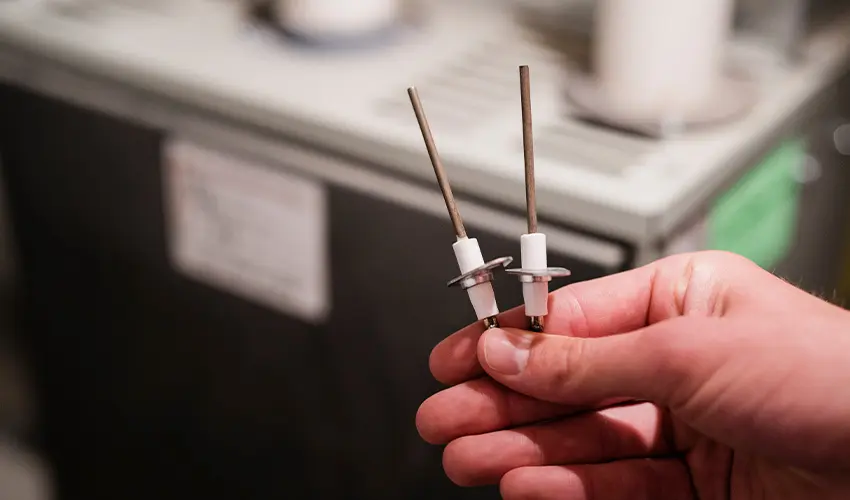
Aire Serv experts explain the importance of a furnace heat sensor for safe and efficient heating.
- Detects burner flame to prevent gas leaks
- Shuts off gas if no flame is detected
- Requires regular cleaning for optimal function
- Replacement may be needed if malfunctioning
Have you ever heard of a furnace heat sensor? This little device, also known as a flame sensor, is an important component inside every furnace. It's an added safety feature designed to prevent carbon monoxide from escaping into your home. But how does it work?
The furnace heat sensor makes sure there is a flame burning inside of the furnace. If the flame extinguishes, unburned gas will escape from the system. Gas may fill the home, which can cause carbon monoxide poisoning or an explosion.
The furnace flame sensor, however, helps to prevent this dangerous scenario. It creates a small electrical current to detect the presence of a flame or not. If the flame goes out, the sensor will shut off the entire system and prevent a gas leak. This little rod could save your entire family!
That's why knowing how to care for the heat sensor is a must.
Signs of a Failing Heat Sensor
If the flame sensor stops working, it could put your family or home in jeopardy. Since gas is invisible and odorless, it's impossible to tell if you have a problem until it's too late. Luckily, a failing heat sensor is easy to spot.
The most common signs are:
- The furnace turns on but shuts off after only a few seconds.
- You find cracks on the porcelain covering the heat sensor.
- You notice soot or corrosion on the flame sensor.
While these signs could indicate a problem with your flame sensor, don't go out and buy a new part just yet. Although the sensor can go bad, often, carbon buildup is to blame. Cleaning the furnace flame sensor could resolve all your problems. In other instances, a short-cycling furnace could point to electrical problems.
Why is Cleaning a Furnace Flame Sensor Important?
A dirty heat sensor can't do its job efficiently. Over time, dirt can accumulate on the sensor, and the system will struggle to warm your home—not how you want to spend winter! But cleaning the furnace flame sensor may be all it takes to get it working again.
How to Clean a Furnace Flame Sensor
- Cut the Power: Just turning off the thermostat isn't enough. Before working on the furnace, make sure to turn off the unit completely and shut off the electric power to the furnace at the breaker box. Safety first!
- Remove the Heat Sensor: Removing the flame sensor only requires a screwdriver. Where is the heat sensor in a furnace? You'll find it towards the back of the unit. Look for a rod-shaped device in the path of the burner—that's the sensor. Loosen the screws and pull it down from the bracket.
- Clean the Sensor: Using either emery paper or light-grit sandpaper, gently rub off any residue on the metal rod. Don't scrub too hard—doing so may scratch and damage the sensor. After cleaning, wipe away any dust with a lint-free cloth.
- Replace the Flame Sensor: Reattach the sensor to the furnace and tighten the screws. Turn the furnace back on to check your work.
Cleaning the sensor only takes a few minutes, and it may extend the life of your furnace. Be sure to inspect it each season to make sure the sensor is free from dirt and residue. However, if your system still doesn't work right, it may be time to replace the sensor or service the furnace.
Choose Aire Serv to Keep Your Furnace Running Optimally
If you continue to experience problems with your furnace after cleaning the heat sensor or if you aren’t comfortable cleaning your flame sensor, contact your local Aire Serv®. Our expert service professionals have the training and experience to keep your HVAC system in tip-top shape all year long. Request an appointment online or call (855) 679-0011 to make sure your furnace is winter-ready.

